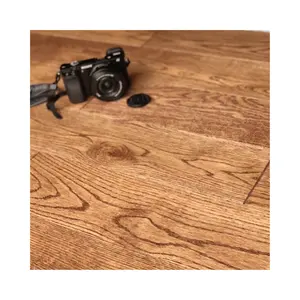


















Red oak flooring refers to flooring made from red oak wood, which is a popular hardwood species. It is valued for its durability, hardness, and attractive grain patterns. It has a distinctive reddish-brown color, although the shade can vary from light pink to a deep, rich red. The wood has a relatively straight grain with a coarse texture. It is known for its ability to take stain well, allowing for a range of color options when finishing the flooring.
The primary use of red oak hardwood flooring is, of course, as a flooring material. Its warm, reddish-brown tones add a timeless and classic look to any room. Red oak flooring is known for its durability and resistance to wear, making it suitable for high-traffic areas. The flooring complements various interior design styles, from traditional to contemporary. Its natural beauty and warm undertones can enhance the overall aesthetics of a space. Moreover, red oak flooring is a popular choice for residential homes, including living rooms, bedrooms, hallways, and kitchens. It provides a long-lasting surface that can withstand the demands of daily life.
Due to its durability, red oak flooring is often used in commercial spaces such as offices, retail stores, and restaurants. It can handle heavy foot traffic and is resistant to scratches and dents. Also, red oak is known for its ability to take stains well. Red oak floor stains allow homeowners and designers to customize the flooring to match specific color preferences or design themes. Red oak flooring is available in various cuts, including plain-sawn, quarter-sawn, and rift-sawn, each offering a different grain pattern. This versatility allows for numerous designs possibilities to suit different tastes.
Red oak floors are more budget-friendly compared to some other hardwood flooring options, making it an attractive choice for those seeking a balance between cost and quality. Also, Installing red oak flooring can add value to a home, as it is a sought-after feature in real estate. Potential homebuyers often appreciate the durability and aesthetics of hardwood floors. Hardwood floors, including red oak, are hypoallergenic and do not harbor allergens or trap dust particles, contributing to better indoor air quality. Moreover, red oak is a renewable resource, and responsible harvesting practices ensure that new trees are planted to replace those that are cut down, making it an environmentally friendly choice. Also, red oak is known for its stability, meaning it is less prone to expansion and contraction with changes in humidity compared to some other hardwoods.
The most common cut for red oak flooring is plain sawn boards. It showcases a traditional cathedral grain pattern with wide, sweeping curves. Also, there are sawn boards that exhibit a straight, tight grain pattern with distinctive ray flecks, often referred to as "tiger striping." This cut is highly prized for its unique and upscale appearance. Moreover, there is unfinished red oak flooring that features intentional distressing techniques to give the floor a worn or aged look. This can include hand-scraping, wire brushing, or other methods to create a rustic appearance. Finally, there is engineered red oak flooring that is composed of multiple layers, with a top layer of red oak and underlying layers of plywood or high-density fiberboard (HDF).